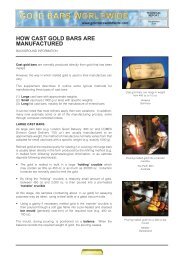Indian Gold Book:Indian Gold Book - Gold Bars Worldwide
Indian Gold Book:Indian Gold Book - Gold Bars Worldwide
Indian Gold Book:Indian Gold Book - Gold Bars Worldwide
Create successful ePaper yourself
Turn your PDF publications into a flip-book with our unique Google optimized e-Paper software.
MUMBAI GOLD PRICES<br />
<strong>Indian</strong> gold prices are normally expressed in rupees per 10 g at 995 purity, or per 10 tola at 999 purity.<br />
Over the past 10 years, the difference between the Mumbai and London gold price has steadily narrowed.<br />
In 1990, the Mumbai premium averaged 56%. In 2001, it averaged 9%.<br />
MUMBAI<br />
The prevailing price of standard gold in Mumbai is widely accepted as a national benchmark.<br />
The Mumbai price reflects the international US dollar price, the rupee exchange rate with the US dollar (the official, as well<br />
as the unofficial cash and hawala rates), and the level of local gold supply and demand. It also takes into account bar import<br />
costs (including Customs duty), and applicable State sales and other taxes in Mumbai.<br />
The standard gold price in other cities and towns can be slightly higher or lower than the Mumbai price, dependent on local<br />
rupee exchange rates, State and municipal taxes, bar transportation costs, and their own level of local gold supply and<br />
demand.<br />
The relevant standard gold price then determines the local price of 10 tola bars, and the local price per gramme at which<br />
jewellery retailers sell, exchange and buy back gold jewellery at 22 carat and other caratages.<br />
Bank prices for 10 tola bars at 999 purity are now also widely publicised.<br />
This has occurred since November 1997, when authorised banks started importing gold bars. As banks rely on imported<br />
gold bars, and do not buy bars on the secondary market, their prices can sometimes be above the standard gold price.<br />
SOURCES<br />
There are no accessible statistics that record Mumbai’s highest, lowest and average monthly and annual gold prices, and<br />
Mumbai’s variation from London gold prices, back to 1970. In addition, many published statistics, relating to the 1970s and<br />
1980s, appear to use prices on the last trading day of March, or India’s April - March financial year average, as indicative<br />
calendar year averages.<br />
When referring to the tables in this section, the following can be noted:<br />
Period 1970 - 1989<br />
Rupee gold prices. The price in Mumbai on the last trading day of March, as recorded by The Bombay Bullion Association<br />
Ltd.<br />
US dollar gold prices. The average for March at the London gold fix, as recorded by Samuel Montagu & Co Ltd in its<br />
historical bulletins.<br />
Rupee/US dollar exchange rates. The annual period rate, as recorded by the IMF in its International Financial Statistics<br />
Yearbook.<br />
Difference between Mumbai and London prices. It is only indicative as the average US dollar price for March is compared<br />
to the rupee price on the last trading day of March.<br />
Period 1990 - 2001<br />
Based on statistics compiled by Madhusudan Daga, who provides many of the statistics normally published by The Bombay<br />
Bullion Association Ltd.<br />
Rupee gold prices. Average monthly and annual prices in Mumbai.<br />
US dollar gold prices. Average monthly and annual prices at the London fixes. The annual average is the average of the<br />
monthly averages.<br />
Rupee/US dollar exchange rate. Official average monthly and annual rates, based on daily rates recorded in Mumbai.<br />
Both periods<br />
Equivalent London gold price in rupees per 10 g. Based on the official exchange rate, 10 g equals 0.32151 oz, and purity<br />
at 995.<br />
AN INTRODUCTION TO THE INDIAN GOLD MARKET 147

















